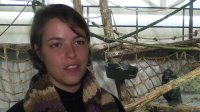Male bonobo Bolombo. © Fabienne Voncken
The alarm went off at six o’clock in the morning every Saturday and Sunday. A two-hour bus ride preceded a long observation session, with pen and paper on her lap and a stopwatch in her hand. This is how Manon Römkens (26) spent her weekends over two winters. On a voluntary internship at Apenheul Primate Park in Apeldoorn, the Bachelor’s student of biology studied stereotypical behaviour in the 12-strong colony of bonobos at the zoo. ‘At four o’clock in the afternoon, the zookeepers came over to tell me it really was time to go home now.’
Kinky positions
Bonobos are famous for their rich sex lives. They use sex not just to reproduce but also to reinforce social relationships or to defuse conflicts. The animals in Apenheul certainly live up to their reputation, says Römkens. ‘I couldn’t believe my eyes the first week. Males with males. Males with females. Females with females. And in different ways all the time, too. We humans could pick up some ideas from them. And the young just go and sit in the middle of it all, to learn how it’s done.’
Not all visitors to the zoo appreciate being confronted with the antics of their distance relatives. ‘I once heard a little boy asking his mum what those monkeys were doing. The mother stuck to her story that she had no idea, she had never done anything like that. For goodness’ sake.’

Manon Römkens in Apenheul Primate Park.
Who is watching who?
The appeal of bonobos, according to Römkens, is that they are so similar to humans. Along with chimpanzees, these are our closest relatives among the apes. ‘If you look them in the eyes you see yourself. They each have unique personalities. When toddlers play, or when a mother kisses her baby, I saw them laugh. That’s really the most beautiful thing in the world. If there are a lot of visitors, some apes stare back at the people. Sometimes I wondered: who is watching who here?
After two months the apes started to recognize Römkens. ‘If I drummed on the floor – never knock on the window! – the toddlers came over to me and ran up and down in front of the window. Just like a game of catch.’ The relationship she built up with the animals made staying objective quite a challenge. Her supervisor at Apenheul taught her to look with the eyes of her scientist. ‘If I had the impression an ape was feeling sad, he kept on asking what observations I based that on. Now I realize how difficult it is to draw hard conclusions about animal welfare.’
Stereotypical behaviour
During her observations, Römkens looked at the frequency and duration of stereotypical behaviour. Behaviour is classed as stereotypical if it is repetitive and has no obvious function. It can arise due to tension or frustration when animals are not living in their natural habitats. Some bonobos in Apenheul, for instance, pluck each other’s hairs out. ‘Hair-plucking in the monkeys is thought to be a sign of stress. Another possible explanation is that a single animal started doing it at some point and the rest of the colony copied it.’
Römkens compared the behaviour of the animals in two sections of their winter enclosure. ‘In the smaller section of the enclosure I thought I observed an increase in hair-plucking. And the animals started grooming each other more, which may be a strategy for releasing tension.’ Unfortunately her observations were not significant enough to provide the basis for a firm conclusion. But she was allowed to submit her study as a special ‘capita selecta’ paper, and she used the results in her Bachelor’s thesis. ‘My supervisor at Apenheul had advised me to ask about that at WUR. It’s really great that I got credits for my voluntary internship.’
The interns at Apenheul not only do research, they also keep an eye on the animals. ‘Things can go wrong in the group at any time. Then it is important to bring in the zookeepers in good time. The bonobos’ winter enclosure was divided into two sections, for instance, because there was too much tension between the alpha female and a male that didn’t accept her authority. The disadvantage is that you sometimes split up the group.’ Another issue is enrichment of the enclosure. ‘On my advice, the zookeepers hung up an extra block for hiding food in. But too much enrichment can have the wrong effect, because it increases the competition for these objects. The keepers are constantly weighing up these kinds of considerations.’
I know how difficult it is to draw hard conclusions on animal welfare
Manon Römkens
Threatened
Apenheul Primate Park is cautious about publicizing Römkens’ research on stereotypical behaviour. She understands that: ‘Visitors form judgements after just one day. Personally I’m very cautious about forming an opinion. Zoos face a difficult dilemma. They participate in breeding programmes to save threatened species but the more animals they keep, the less space there tends to be per animal.’ Römkens would prefer to see the monkeys in their natural habitat, but she sees breeding programmes as a necessity. Bonobos are only found in the wild in the forests of the Congo. Poaching and loss of habitats are threatening the species with extinction.
Römkens is determined not to let that happen. She hopes to continue to do behavioural research on apes in future. She is also a volunteer with the Worldwide Fund for Nature. She tries to communicate her message positively. ‘I think there is much to be gained by getting people interested. They are such hilarious animals. They are so like us. How could you fail to like them?’
